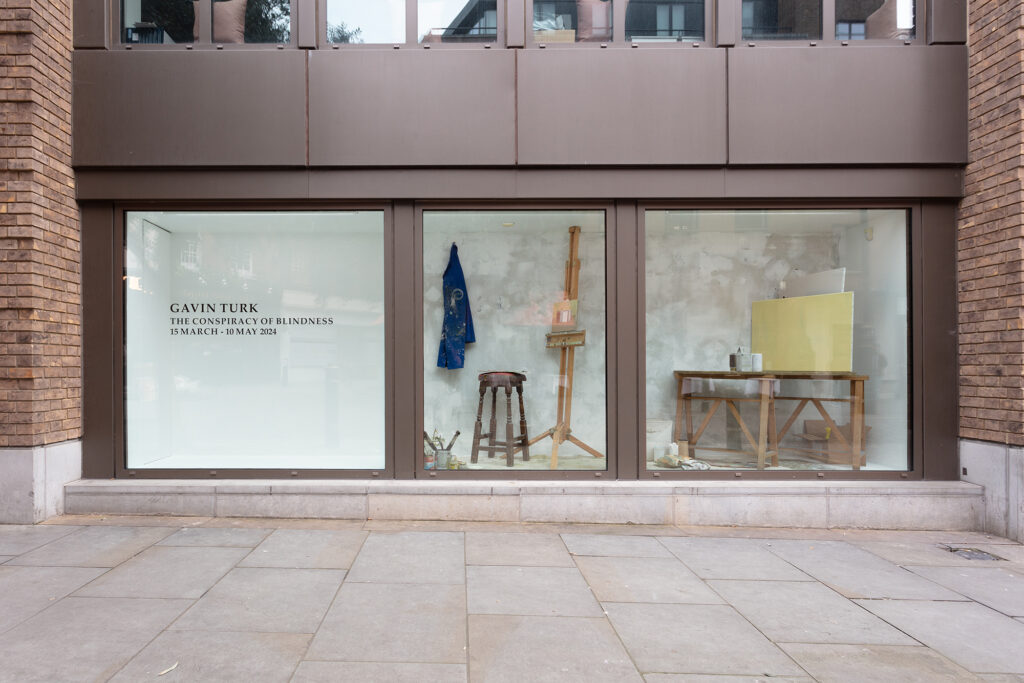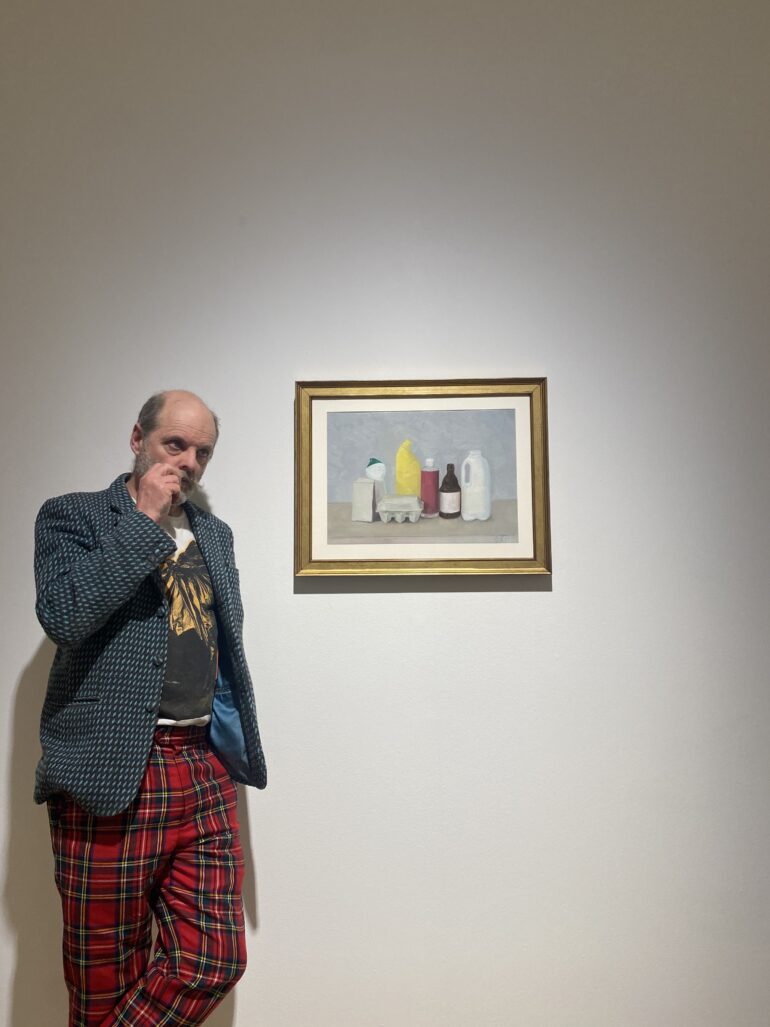Culturalee spoke to Gavin Turk about his latest solo exhibition, The Conspiracy of Blindness, at Ben Brown Fine Arts in London. Turk takes inspiration from 20th Century Italian artist Giorgio Morandi and puts his own unique spin on Natura Morta painting by depicting mundane, everyday objects such as cleaning products and sauce bottles. Turk’s Magrittian exhibition title The Conspiracy of Blindness is a reference to contemporary society’s over-consumption and throwaway culture.

Is your exhibition The Conspiracy of Blindness at Ben Brown a version of your recent ‘Still Life’ solo show at Maruani Mercier Knokke gallery in Belgium? And where did the title come from?
The Magrittian show title comes from the Idea that there is a conspiracy of blindness to waste. Currently over-consumption is an ideological norm that is part of the systemic breakdown of the environment that itself challenges a habitable world.
Since September last year, I have been concentrating on a series of paintings of empty packaging from stuff I have consumed. The still lifes re-frame these objects, creating portraits of waste. The shapes and colours of the objects often ‘supermarket’ familiar return the viewer to the historical and technical necessity of packaging.
The show The Conspiracy of Blindness at Ben Brown gallery is a continuation of the exhibition ‘Still Life’ at Maruani Mercier gallery in Belgium that took place at the end of last year.

You’ve described yourself as a ‘domestic anthropologist’, what do you mean by that?
‘Domestic anthropology’ is a new concept I am exploring. I understand it as an exploration into the familiar items of home life, through the lens of the uncanny or the unheimlich (un-homely). Mundane objects such as the black bin bag on the doorstep reflect societal interpretations. Everyday actions like going to the local shop signify identity politics, showcasing cultural boundaries. Notions of waste become central to the search for value and by implication what is believed to be real.
The paintings featured in The Conspiracy of Blindness are inspired by 20th Century Italian artist Giorgio Morandi, yet you have decided to depict ordinary objects such as unbranded sauce bottles and cleaning products. What is it about seemingly mundane, everyday objects that inspires you to make them focal points or your artworks?
Giorgio Morandi has become a kind of standard in relation to the still life painting; ‘Natura Morta’ (in Italian crudely translated as dead nature)
He painted over a 1000 small pictures of a limited number of vessels, vases, cups and pots with particular attention to the light. The paintings have a minimal background, painted in his bedroom studio and are often reduced to a single line; table and wall behind.
My paintings are of emptied packaging, taken from my kitchen and placed in my studio. I then curate mise en scene with the objects, sometimes overpainting the outside of the forms, or the insides. I am interested in the graphical element of the objects; however, in this Morandi-esque process, it’s not my focus. I am enjoying questioning the classical mythical lens of painting, by using it to depict what would normally be discarded.

You have a busy exhibition schedule for 2024 including a group show in France, ‘Faire Corps’ at FoundationVilla Datris’ in May and ‘Rebel Garden’ at the Musea Brugge in April. Are there any exhibitions or collaborations you’re particularly excited about this year?
I am excited to be putting together a catalogue around this new series of still lifes, of which Darian Leader (British psychoanalyst and author) has already written an excellent essay. Following this, I am looking at various public sculptures and speaking with Museums on solo exhibitions on new works and retrospectives. News to follow soon…
You are one of the OG ‘Young British Artists’, since your 1991 MA exhibition, where you presented a whitewashed studio space containing a single blue heritage plaque commemorating your presence, attracted the attention of Charles Saatchi. Do you ever tire of the Moniker YBA?
Yes, I think the main point is it was a very useful shorthand to talk about a particular moment in history. I suppose I’m less interested in my past and more interested in the present. Obviously, I do like to bring art history into the present! I continue to experiment, in the search of my metier.

As a multi-disciplinary artist, do you enjoy the audience interaction that your outdoor sculptures inspire – such as the monumental door that you exhibited in Frieze Sculpture Park a couple of years ago – as opposed to the less participatory experience viewers are offered through your paintings?
I enjoy any or all forms of engagement with my work. I like the audience to be involved, whether it’s spiritually, physically or conceptually. LÂge d’Or (Green & Red), 2019 was brilliant at Frieze, it’s now permanently placed in Rotterdam directly opposite the Fenix Migration Museum, as part of Sculpture International Rotterdam.
I do think however, that the painting exhibition is something of an installation. The window of the gallery has an assemblage mimicking my studio set up and within the show, each frame is carefully considered. As such it gives a sense that each work has had a lived experience, and then been recalled especially for this exhibition.
During more than three decades of artistic practice, you have challenged perceived notions of value, identity, authorship and identity through your work, sometimes referencing modern masters, other times placing yourself in your artworks. Where does your inspiration come from, and what is the starting point for each oeuvre?
For me, it all starts with a question of origin, a bit like an egg. You crack it open, and there’s this whole world of possibilities inside.
My inspiration? It’s like a compost of art history, everyday experiences, and those lightbulb moments when something just clicks. They often sneak up on me when I’m least expecting it, when I’m deep into something else entirely. My brain’s on this constant treasure hunt for ideas, and sometimes it strikes gold when I’m looking the other way. A bit like solving a puzzle, but the pieces keep changing shape as you go. I love diving into the problem-solving aspect of art, tweaking and tinkering until it feels just right. But, you know, every solution tends to throw up a dozen more questions, which keeps the whole cycle going.
Gavin Turk The Conspiracy of Blindness is at Ben Brown until 10th May, 2024.



